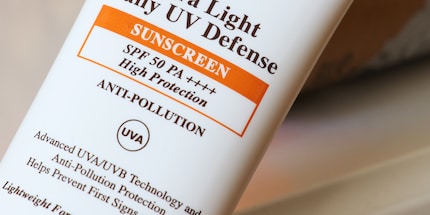
Guide
How much sunscreen does your face need?
by Natalie Hemengül

A large number and all sorts of cryptic abbreviations are found on sunscreens. Keep reading to find out what lies behind the letters and which other packaging instructions are at least as important.
SPF 50 and you’re good to go. For years, I bought my sunscreen based on this simple rule. Too simple. Because I didn’t even know what that abbreviation stood for. Today, I’m smarter.
Sunscreen products protect your skin from so-called ultraviolet radiation. It’s part of the sunlight and not visible to you. When it comes to sun protection, two types of UV radiation are relevant: UVA and UVB.
UVB radiation causes sunburn. The abbreviation SPF tells you how well a sunscreen protects you from sunburn. It stands for «Sun Protection Factor» and is always listed in combination with a number. A number that probably catches your eye first because it’s usually in large print on the front.
The sun protection factor is determined in the laboratory. It indicates the factor by which the product extends the self-protection time of your skin. In theory, this would mean if your skin turns red after ten minutes of UVB exposure without protection, you could stay in the sun 50 times longer with SPF sunscreen without burning yourself. 500 minutes.
Unfortunately, that’s a calculation that doesn’t work out in reality.
What works in the laboratory can’t be transferred 1:1 to the real world.. This is because under test conditions, measurements are made a) with constant UV radiation and b) with two milligrams of sunscreen per square centimetre. In real life, UV radiation is constantly changing depending on the location and time of day. In addition, every skin is different and only very few people apply enough sunscreen. This affects the protection. It's key to reapply suncreme regulary and evenly. In reality, you can’t use the sun protection factor to calculate time.
The factor only quantifies the level of protection. This ranges from 6 to 50+ (article in German). The higher the number, the less UV radiation your sunscreen lets through.
The sun protection factor therefore only gives you information about the UVB filter in the product. But what about the UVA rays? These account for 95 per cent of the UV rays that reach us on Earth.

While the intensity of UVB rays varies depending on the time of day and season, UVA rays are a constant threat to your skin year-round. They cause hyperpigmentation and even DNA damage, which can lead to skin cancer. Unlike UVB, UVA rays also pass through windows as well as clouds and penetrate deeper into the skin. They significantly influence skin ageing. In fact, 80 per cent of ageing signs such as pigmentation and wrinkles are due to UV radiation. According to the Cancer League(article in German), UVA rays also trigger sun allergies.
That’s why it’s important that you apply sunscreen that has a UVA filter every day. Even if you don’t plan to leave the house. UVA filters on sunscreen products are marked with a circled UVA label. This means that the product has a minimum level of protection against UVA rays.
Some products, especially those from the Asian region, additionally list a small rating on the packaging regarding UVA protection. The letters PA followed by one to four plus signs. The number of plus signs tells you how strong the UVA filter in the product is. The more plus signs, the higher the UVA protection in the product. Therefore, make sure that you always use a product with four plus signs (PA++++).
Just looking at the sun protection factor isn’t enough when buying sunscreen. A little basic knowledge will not only save you a wrinkle or two, but in the worst case, can make the difference between life and death.
As a massive Disney fan, I see the world through rose-tinted glasses. I worship series from the 90s and consider mermaids a religion. When I’m not dancing in glitter rain, I’m either hanging out at pyjama parties or sitting at my make-up table. P.S. I love you, bacon, garlic and onions.
Interesting facts about products, behind-the-scenes looks at manufacturers and deep-dives on interesting people.
Show all